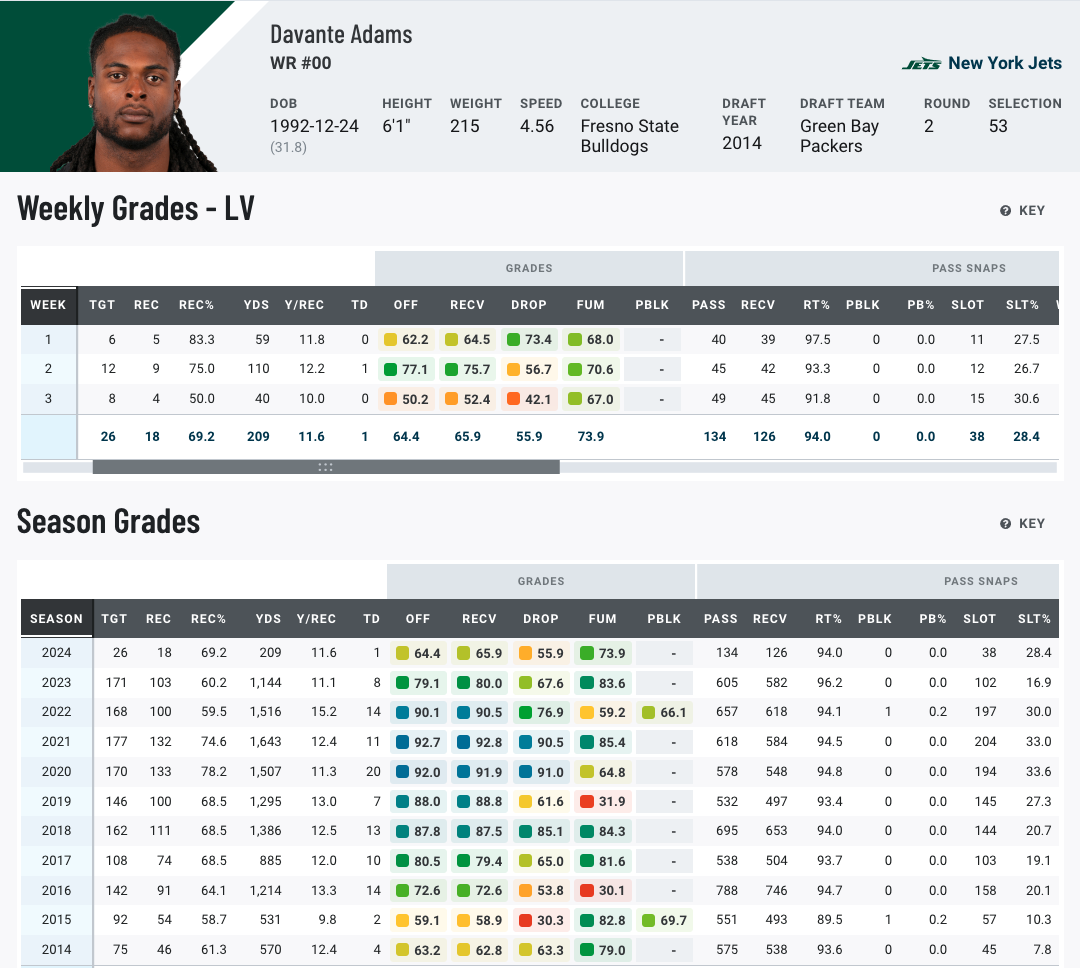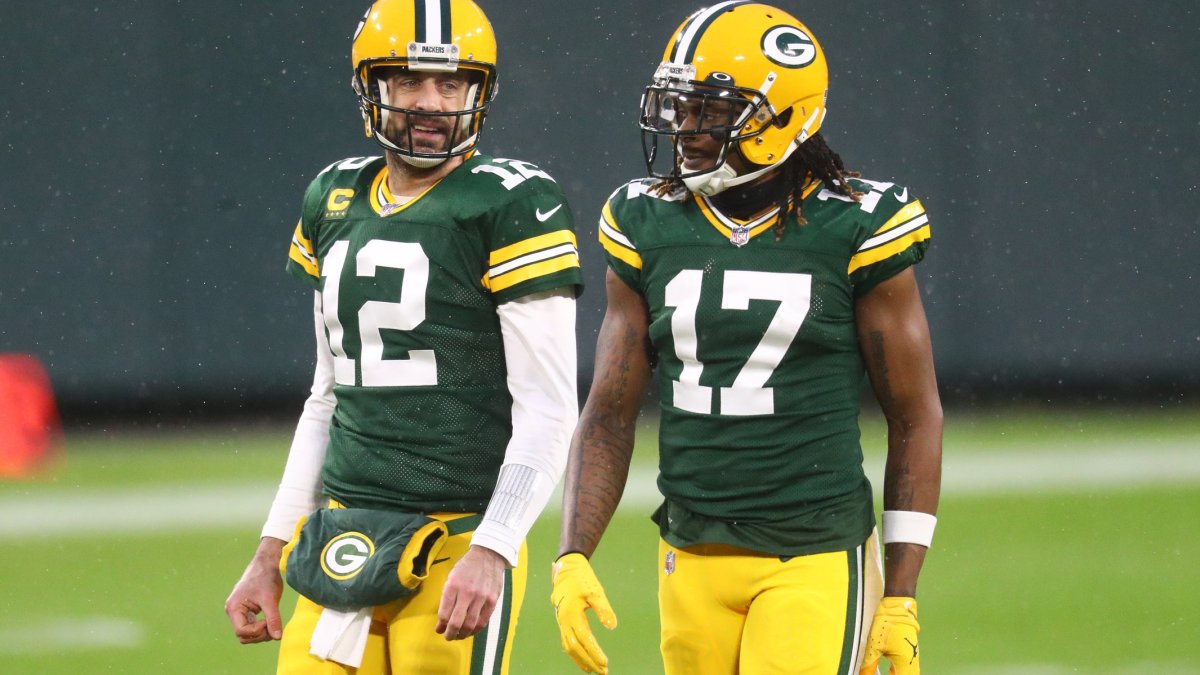• Davante Adams bolsters a receiving corps that's underperformed significantly: The only Jets receiver with a 70.0-plus receiving grade this year is Garrett Wilson.
• Adams' versatile route-running could be big: Over his last three years as a Packer, Adams posted an 83.6 receiving grade or better outs, slants, wide screens, speed outs, gos, hitches and crossing routes.
• Unlock your edge with a PFF+ subscription: Get full access to all our in-season fantasy tools, including weekly rankings, WR/CB matchup charts, weekly projections, the Start-Sit Optimizer and more. Sign up now!
Estimated reading time: 5 minutes
After years of speculation, the inevitable has finally come true.
On Tuesday morning, the New York Jets pulled the trigger on a trade for Las Vegas Raiders receiver Davante Adams, surrendering a conditional third-round pick. In turn, owner Woody Johnson granted Aaron Rodgers his long-awaited wish, reuniting his star QB with his favorite target.
Sitting at 2-4, the Jets are clearly in desperation mode for an instant solution to rectify a highly anticipated season. The team already dismissed head coach Robert Saleh in one of the NFL’s more shocking moves in recent memory, but its offense has been the fundamental problem so far. New York ranks 23rd in EPA per play and 18th in successful play percentage, scoring on just 31.3% of its drives.
The Jets’ lack of offensive success hasn’t been due to Rodgers’ individual play. The 40-year-old ranks eighth among quarterbacks in passing grade this season, and his 12 big-time throws are the second-most in the NFL.
Instead, as Monday night’s performance against the Buffalo Bills revealed, the team needs more cohesion and juice at receiver. The Jets rank 21st in team receiving grade, and only star Garrett Wilson has notched a receiving grade above 70.0 this season. Even then, his 1.63 yards per route run ranks 36th out of 58 receivers with 25 or more targets.
That’s precisely an area that Adams can rectify. Although his 2024 receiving grade sits at only a 65.9, that’s a considerable aberration from where Adams has graded throughout his career.
The 31-year-old has earned a receiving grade of at least 79.0 in seven straight completed seasons. Maybe most remarkable is that Adams’ production or separation ability didn’t wane despite playing with extremely lackluster options under center with the Raiders.

Instead of catching passes from Gardner Minshew or Aidan O’Connell, Adams now rekindles his borderline unstoppable connection with Rodgers. While playing together from 2014-21, the pair formed one of the best quarterback-receiver duos in recent NFL history.
In the PFF era, the Rodgers-Adams pairing ranks fifth among quarterback-receiver duos in targets, plus seventh in yards and second in touchdown passes. Their cumulative greatness led to individual acumen: from 2014-21, Adams' 2.84 PFF WAR ranked fifth among receivers, while Rodgers’ 27.97 WAR was second. Over his career, Rodgers has earned a 95.8 passing grade when throwing Adams' way.
Without question, Rodgers has generated his most individual success when throwing to Adams. Rodgers' 8,439 passing yards and 76 touchdowns to Adams are both tops among any receiver target in his 19-year career. Moreover, Rodgers has recorded a 7.6% big-time throw rate to only a 2.5% turnover-worthy play rate when targeting Adams, good for a 114.6 passer rating.
The most unique aspect of Rodgers’ and Adams’ relationship is that the pair thrived on a slew of route combinations, making them virtually impossible to defend. Over their last three years together as Packers, Adams was targeted 40 or more times on outs, slants, wide screens, speed outs, gos, hitches and crossing routes, posting an 83.6 receiving grade or better on all such route types.
That generally dovetails with what Rodgers has done as a Jet this year, with hitches, speed outs, slants and outs comprising four of his five highest-targeted routes in 2024.

The rapport between the future Hall of Famers likely hasn’t withered much despite not playing catch in three years. From a talent perspective, adding a receiver like Adams should generate favorable matchups against worse corners for Wilson. More specifically, Adams could take the top off a defense deep, while Wilson — who’s recorded a 94.9 receiving grade on passes 10-to-19 yards downfield since entering the league — works more over the middle of the field, potentially in the slot.
The question, though, is how the Jets will implement Rodgers’ and Adams' desires with the existing pieces — and woes.
For instance, how will Adams explicitly help a rushing offense that sits 28th in explosive rushes and 30th in average rushing yards before contact? Will Adams instantly add enough motion to help a unit that ranks 24th in shift/motion rate? Will the fast connection between Rodgers and Adams aid an offensive line that ranks 16th in pass-blocking grade?
The good news for Rodgers and the Jets is that the existing offensive foundation can’t underwhelm much more than it is so far. Plus, making the move for Adams automatically increases the baseline talent with which new offensive coordinator Todd Downing has to work. A nucleus of Rodgers, Adams, Wilson, and Breece Hall — with solid complementary pieces in Williams, Allen Lazard and Braelon Allen — is good enough on paper to produce at a solid efficiency.
At the same time, trading for a 31-year-old receiver owed over $114 million against the cap this year, plus through 2026, bears significant risk. If Adams and Rodgers can’t quickly rekindle their magical, often telepathic relationship from years ago in Green Bay, then more skepticism will grow about the Jets’ short-term contending chances — which are already on thin ice.




 © 2024 PFF - all rights reserved.
© 2024 PFF - all rights reserved.